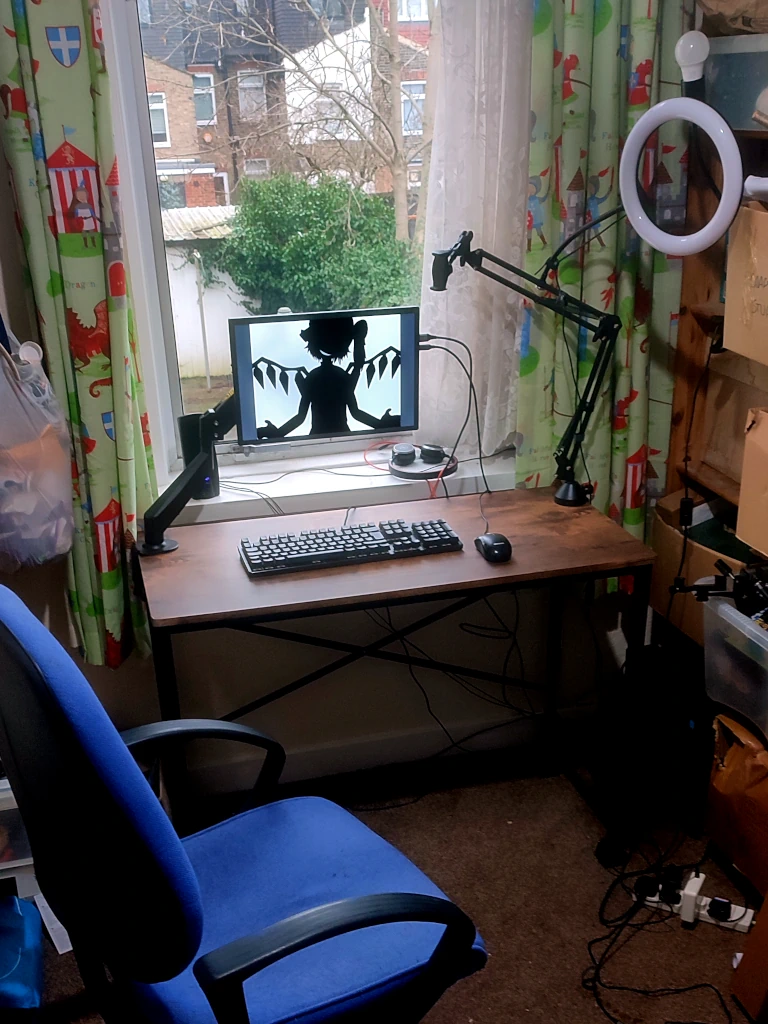I needed a proper writing desk. So I cleared some space in the spare room for a desk, an old desktop PC and a nice mechanical keyboard. (The loved one bought the keyboard several years ago, but the offspring protested the machine-gun noises in the loungeroom.) There wasn’t a lot of room, but a 100×50cm desk for £40 was just the thing. [Amazon UK]
The monitor was an ancient NEC MultiSync LCD1880SX (5:4, 1280×1024), which was the absolute bee’s knees in 2002! In 2025, the fluorescent backlight is clapped out, and the monitor is too dim to use on a sunny day. So it’s free to a good (or bad) home with a hobbyist interested in fixing it. You know where to contact me.
I looked through Amazon for a suitable new monitor, and I discovered an exciting new form of gadget — portable monitors! They’re really laptop screens as a standalone gadget. Light, 10” to 21”, USB-C power, signal via USB-C or mini-HDMI. And portable.
The use case is for laptops in cramped spaces or showing movies off a phone — but the monitors also have 7.5cm VESA mounting holes, so maybe one would make a good PC monitor? Big enough to write on, but small enough not to block out the whole window, as a cheap 24” would have.
I asked on Mastodon and Facebook and got overwhelmingly positive responses. A ton of people have bought these things and are delighted with them. [circumstances.run; Facebook]
The haul
There’s various brands, but I suspect they’re all made in a single factory in Shenzhen.
I browsed portable monitors on Amazon, but I made the purchase itself on eBay, and I advise you do the same. The brands will often have a local distributor with an eBay store. I got an Eviciv 170R01, a 17.3” 1920×1200 (16:10) screen that does 300 nits of brightness. This model is £150 new; I got a refurbished one for £100. Prices vary — shop around. [eBay]
The monitor has two USB-C sockets and a mini-HDMI socket. The USB-C can do video, power or both on the same cable. I could dimly power the screen off the USB video connection to my laptop, but it asked me to “Please Connect Recommended Extra Power.” I did so and it was much brighter.
You’ll need to figure out how to get into the menus and adjust the brightness and contrast to taste. It occasionally forgets the brightness setting and resets to default dimness. Play with the controls, especially the “ECO” setting (I have no idea what that stands for) — text looks good to me with ECO set to “movie” or “RTS.” The pixels are pin-sharp. It plays moving video just fine, as I’d have expected. Sometimes the screen goes weird if brightness is too high.
The default colour balance is a bit blue, but that’s easily adjustable as well. The colours seem a bit washed out. I’m not sure the monitor has a sufficient usable contrast range for serious graphics work — though if anyone reading uses a portable monitor for graphics, please comment. (It’s the sort of gadget a photographer would want to take on a shoot, for example.)
The monitor comes with a protective cover — very like a tablet cover — that sticks to magnets in the back of the screen. This also folds into being a stand.
The USB power adapter (5V, 4A) only had a one metre cable. So I got a 2m USB-C extension cable for it. [Amazon UK, Amazon US]
The display was inverted 180° from what I expected. I checked the monitor’s settings and it was indeed inverted, and I changed it back to 0°. So you can easily use these monitors with the cables going into either side.
The monitor has speakers, though they’re small, quiet and tinny. I wouldn’t bother if you have anything better.
I couldn’t work out how to send video from my phone. (Yes, I still have the Xiaomi phone.) It might need USB 3.2, which is still quite recent in phones.
The PC is a 2019 Lenovo ThinkCentre m93p 10A8 SFF (10A8002CUK) with two DisplayPorts and VGA — just a very dull corporate desktop. Ideal for LibreOffice. It has USB 3.1 with a USB-A socket, but apparently doesn’t do video through the USB. So I got a DisplayPort to mini-HDMI cable for £21, and it works fine. [Amazon UK, Amazon US]
I needed something to mount the display in the window. The standalone monitor stands were too deep for the window sill, so I got a Suptek swing arm with a gas spring for £22.50. It looks smaller in real life than in the Amazon picture. It supposedly takes televisions up to 6kg, so an 800g screen is no problem. [Amazon UK, Amazon US]
I clamped the arm to the desk. It’s nicely positionable. The provided Allen keys adjust how stiff the joints are.
The monitor comes with 4mm-long VESA mounting screws that need a tiny Allen key (not provided). These kept popping out when I tilted the screen. But the screw holes are actually smaller than standard VESA — so I couldn’t switch to using the screws that came with the arm. How annoying.
Total cost: £100 for the monitor and about £50 for accoutrements.
Here’s the monitor positioned for use. The PC is on the floor at the right. On the window sill is a headset [Amazon UK, Amazon US] and some extremely cheap speakers that are still better than the monitor’s. The family got me the ring light phone mount for Christmas, suggesting I go rant on TikTok when something annoyed me. [Amazon UK, Amazon US] At top right you can see a clip-on light bulb. [Amazon UK, Amazon US]
The verdict
The monitor is bright enough to use with a sunny day behind it. The screen is at the right height and I can easily bring it forward or push it to one side.
It could do with being a bit bigger. I wouldn’t mind a 19” or 20” monitor mounted the same way, if I can find one bright enough — anything more than that would be a bit much for the space.
But that can wait. This does the job and I can write on it.
Anyway, get yourself a portable monitor. They’re ace.
Your subscriptions keep this site going. Sign up today!

